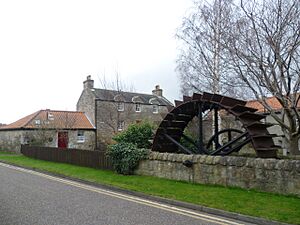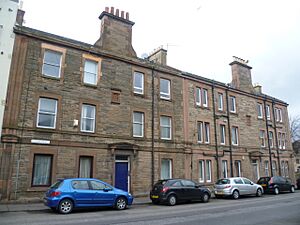Bonnington, Edinburgh facts for kids
Bonnington is a neighbourhood in Edinburgh, the capital city of Scotland. It grew from an old village located near a crossing point (a ford) on the Water of Leith river. This area was once on the border between Edinburgh and the port of Leith. Before Leith Walk was built, the road through Bonnington was one of the main ways to travel between Edinburgh and Leith. Today, Bonnington is found between the areas of Pilrig and Newhaven.
Contents
Bonnington's Story
The land and mills in Bonnington were part of a larger area called the Barony of Broughton. This was mentioned in a special document from King David I in 1143. Like other nearby villages, Bonnington was known for its mills. These mills used the power of the river to grind grain and do other work.
Tough Times in the Past
In the 1540s, Bonnington faced difficult times. Armies passed through the village in 1544 and again in 1547. These events were part of a period of conflict known as the Rough Wooing.
A Dutch Dyer and Old Buildings
In 1617, the land and mills were sold to the Town Council of Edinburgh. In 1621, a Dutchman named Jeromias van der Heill was invited to Bonnington. He was a dyer, and he came to teach his special craft to people in the area. The house built for him, later called Bonnyhaugh, is still standing today.
When the old mill buildings were taken down in the 1980s, Bonnyhaugh House was saved. It was repaired and turned into apartments. The small building next to it was originally the dyeing room. Later, it became a blacksmith's workshop, known as a smiddy.
The Waterwheel and River Power
A large waterwheel from the Bonnington Mills was saved. In the 1980s, it was moved to a new spot where the mill lade (a channel that carried water to the mill) used to be. A gate at a nearby weir (a small dam) controlled the water level in the lade. The power from the water was used for many things. It helped to mill grain, weave cloth, prepare leather, and even make paper.
Roads and Bridges
At the end of the 1700s, Bonnington Road became a toll road. This meant people had to pay to use it, which is why the area at the Newhaven Road junction is called Bonnington Toll. The old toll house, where people paid, is still there at the Leith end of the road.
A bridge was built over the river crossing in 1812. This bridge was later replaced by the one we see today, which was built between 1902 and 1903.
Local Industries and Changes
In 1832, a company owned by Robert Burns (not the famous poet) had a leather factory at the site of Bonnington Mills. The Burns tenement, an apartment building on Newhaven Road, was built to house the workers from this factory. It was updated in the 1970s. You can see a stone carving on the building that shows a sheep and tools used by leather workers.
The Bonnington Chemical Works on Newhaven Road started in 1822. It processed waste materials from making coal gas in Edinburgh and operated for about 50 years.
During the 1800s and 1900s, the area north of Bonnington Road became a mix of factories, businesses, and shops. This included a large printing company, a sugar warehouse, and engineering workshops. Some of these places have closed or been changed into new uses in recent years. For example, a large storage building for the John Lewis Partnership was built in the 1980s.
Schools and Flood Defences
The former Bonnington Church joined with another church in 1968. New homes built along the river have changed the look of the area around Bonnington Mills. This also led to work being done to improve flood defences to protect the new buildings.
The old Bonnington Primary School reopened on August 16, 2013, as Bun-sgoil Taobh na Pàirce. This was Edinburgh's first school where lessons are taught in the Scottish Gaelic language.
Industries in Bonnington
Over the years, many different businesses and factories have been located on both sides of the Water of Leith in Bonnington. Some of these include:
- The original Chancelot Mill, which was a large flour mill.
- Dofos dog food factory.
- The Bonnington Chemical Works, which operated from 1822 to 1878.
- Powderhall Bronze, a modern company that makes metal sculptures.
- The Scottish tachometer centre, which deals with devices that measure speed.
- Dulux Paints.
- Farmer Jacks.
- A very large warehouse for storing whisky at Anderson Place, which has now been turned into homes.
- James Pringle shopping warehouse.
- A yard for cutting and shaping stone and marble.
- A factory that made cardboard boxes on Bonnington Road, which is now also housing.
In the 1960s, some old apartment buildings on Graham Street were removed to make way for factories. However, by 2000, new homes were built there instead. While the area used to be mainly for industry, recent changes mean that more and more homes are being built.
Famous People from Bonnington
Some notable people have connections to Bonnington:
- Leslie Balfour-Melville
- Robert Keith, who once lived in Bonnyhaugh House.
- Edmund Ronalds, who lived at Bonnington House.





